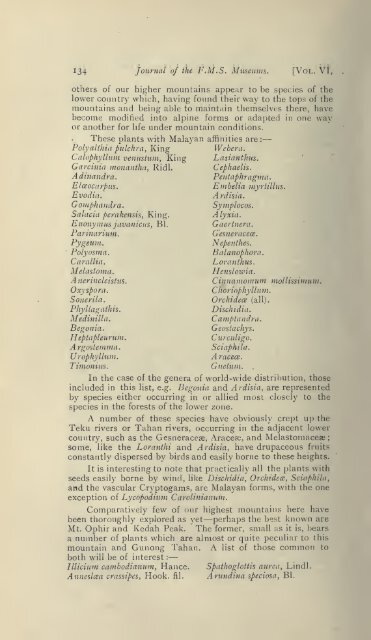Journal of the Federated Malay States museums - Sabrizain.org
Journal of the Federated Malay States museums - Sabrizain.org
Journal of the Federated Malay States museums - Sabrizain.org
You also want an ePaper? Increase the reach of your titles
YUMPU automatically turns print PDFs into web optimized ePapers that Google loves.
' Polyosma.<br />
134 journal <strong>of</strong> tJu b\M.S. Museums. [Vol. VI,<br />
o<strong>the</strong>rs <strong>of</strong> our higher mountains appear to be species <strong>of</strong> <strong>the</strong><br />
lower country which, having found <strong>the</strong>ir way to <strong>the</strong> tops <strong>of</strong> <strong>the</strong><br />
mountains and being able to maintain <strong>the</strong>mselves <strong>the</strong>re, have<br />
become modified into alpine forms or adapted in one way<br />
or ano<strong>the</strong>r for life under mountain conditions.<br />
These plants with <strong>Malay</strong>an affinities are:<br />
Polyalthia pulchva, King Wehera.<br />
Calophylluni veniistuni, King Lasianthus.<br />
Garcinia monantha, Ridl.<br />
A dinandra.<br />
Cephaelis.<br />
Pentaphragmn.<br />
Elceocarpns. Einbelia myrtillus.<br />
Evodia. Ardisia.<br />
GoDiphandra. Symplocos.<br />
Salacia perakensis, King. Alyxia.<br />
Euonymiis jav aniens, Bl. Gaertnera.<br />
Parinarium. Gesneracece.<br />
Pygeuni. Nepen<strong>the</strong>s.<br />
Balanophora.<br />
Carallia. Loranthiis.<br />
Melastonia. Henslowia.<br />
A nerincleistus. CinnainoviMn mollissimuin.<br />
Oxyspora. Choriophyllinu.<br />
Sonerila. Orchidece (all).<br />
Phyllagathis. Dischidia.<br />
Medinilla. Camptandra.<br />
Begonia. Geostachys.<br />
Heptaplenrum. Cnrcnligo,<br />
A rgosteimna. Sciaphiln.<br />
Urophyllum. Aracece.<br />
Timonius. Gnetum.<br />
In <strong>the</strong> case <strong>of</strong> <strong>the</strong> genera <strong>of</strong> world-wide distribution, those<br />
included in this list, e.g. Begonia and Ardisia, are represented<br />
by species ei<strong>the</strong>r occurring in or allied most closely to <strong>the</strong><br />
species in <strong>the</strong> forests <strong>of</strong> <strong>the</strong> lower zone.<br />
A number <strong>of</strong> <strong>the</strong>se species have obviously crept up <strong>the</strong><br />
Teku rivers or Tahan rivers, occurring in <strong>the</strong> adjacent lo\Ner<br />
country, such as <strong>the</strong> Gesneraceae, Araceae, and Melastomaceae<br />
some, like <strong>the</strong> Loranthi and Ardisia, have drupaceous fruits<br />
constantly dispersed by birds and easily borne to <strong>the</strong>se heights.<br />
It is interesting to note that practically all <strong>the</strong> plants with<br />
seeds easily borne by wind, like Dischidia, Orchidece, Sciaphila,<br />
and <strong>the</strong> vascular Cryptogams, are <strong>Malay</strong>an forms, with <strong>the</strong> one<br />
exception <strong>of</strong> Lycopodiwn Carolinianum.<br />
Comparatively few <strong>of</strong> our highest mountains here have<br />
been thoroughly explored as yet— perhaps <strong>the</strong> best known are<br />
Mt. Ophir and Kedah Peak. The former, small as it is, bears<br />
a number <strong>of</strong> plants which are almost or quite peculiar to this<br />
mountain and Gunong Tahan. A list <strong>of</strong> those common to<br />
both will be <strong>of</strong> interest :<br />
Illicium camhodianuni, Hance. Spathoglottis aurea, Lindl.<br />
Anneslcea crassipes, Hook. fil. Arundina speciosa, Bl.

















